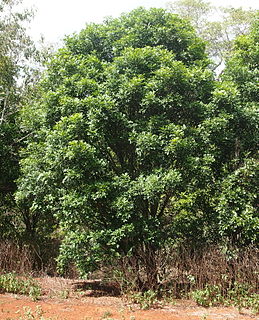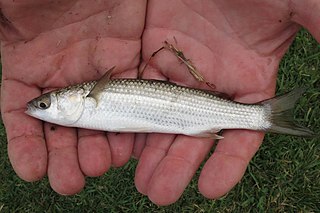
The Cape crow or black crow is slightly larger than the carrion crow and is completely black with a slight gloss of purple in its feathers. It has proportionately longer legs, wings and tail too and has a much longer, slimmer bill that seems to be adapted for probing into the ground for invertebrates. The head feathers have a coppery-purple gloss and the throat feathers are quite long and fluffed out in some calls and displays.

The Cape teal also Cape wigeon or Cape widgeon is a 44–46 cm long dabbling duck of open wetlands in sub-Saharan Africa.

The Cape lobster, Homarinus capensis, is a species of small lobster that lives off the coast of South Africa, from Dassen Island to Haga Haga. Only a few dozen specimens are known, mostly regurgitated by reef-dwelling fish. It lives in rocky reefs, and is thought to lay large eggs that have a short larval phase, or that hatch directly as a juvenile. The species grows to a total length of 10 cm (3.9 in), and resembles a small European or American lobster; it was previously included in the same genus, Homarus, although it is not very closely related to those species, and is now considered to form a separate, monotypic genus – Homarinus. Its closest relatives are the genera Thymops and Thymopides.

The Cape hare, also called the desert hare, is a hare native to Africa and Arabia extending into India.

The Cape cormorant or Cape shag is a bird endemic to the southwestern coasts of Africa.

The spotted thick-knee, also known as the spotted dikkop or Cape thick-knee, is a wader in the family Burhinidae. It is native to tropical regions of central and southern Africa.

The Cape weaver is a species of bird in the weaver family, Ploceidae, found in southern Africa.

The yellow bishop, Cape bishop, Cape widow or yellow-rumped widow is a resident breeding bird species in Angola, Botswana, Burundi, Cameroon, Congo, Equatorial Guinea, Eswatini, Ethiopia, Kenya, Lesotho, Malawi, Mozambique, Nigeria, Rwanda, South Africa, South Sudan, Tanzania, Uganda, Zambia and Zimbabwe.

Sebastes capensis, the false jacopever or Cape redfish, is a species of marine ray-finned fish belonging to the subfamily Sebastinae, the rockfishes, part of the family Scorpaenidae. It is found in the South Atlantic Ocean and may also occur off southern and western South America.

Atalaya is a genus of eighteen species of trees and shrubs of the plant family Sapindaceae. As of 2013 fourteen species grow naturally in Australia and in neighbouring New Guinea only one endemic species is known to science. Three species are known growing naturally in southern Africa, including two species endemic to South Africa and one species in South Africa, Swaziland and Mozambique.
The Cape York mosaic-tailed rat, or Cape York melomys is a species of rodent in the family Muridae. It is found only in Australia, on the Cape York Peninsula.

The micro frog, or Cape Flats frog, is a species of frog less than 2 cm (0.8 in) long in the family Pyxicephalidae, in the monotypic genus Microbatrachella. Its color varies from rufous brown with dark mottling, to tan or green, depending on the population. It is endemic to the south-western Cape area of South Africa, with a single population found on the Cape Flats of Cape Town and several populations on the eastern side of False Bay. It typically lives in wetlands in coastal fynbos habitats, but its total area of occupancy is very small, and the International Union for Conservation of Nature has rated it as being "critically endangered".

The Cape horseshoe bat is a species of bat in the family Rhinolophidae. It is endemic to South Africa, and is potentially threatened by habitat loss and disturbance of its roosting sites, although it is present in large enough numbers to be considered of least concern by the IUCN.

The Cape flat lizard or Namaqua flat lizard is a lizard in the Cordylidae family found in Namibia and South Africa.

The freshwater mullet is a species of fish in the family Mugilidae. It is endemic to South Africa.

The Cape kurper is a species of fish in the family Anabantidae, the climbing gouramis or climbing perches. It is endemic to South Africa.
Atalaya natalensis, also called Natal wing-nut, is a species of plant in the family Sapindaceae. It is endemic to the Cape Provinces and KwaZulu-Natal in South Africa. It is threatened by habitat loss.

Merluccius capensis is a ray-finned fish in the genus Merluccius, found in the south-eastern Atlantic Ocean, along the coast of South Africa. It is a long, lean fish with a large head, similar in appearance to the European hake and the deep-water Cape hake. By day, it lives close to the bottom on the continental shelf and upper slope at depths not usually exceeding 400 m (1,300 ft); it makes a large, daily vertical migration rising at night to feed in the nectonic zone, and it also migrates southwards in spring and northwards in autumn. It is an important commercial fish species in southern Africa.

The Cape horse mackerel is a mackerel-like species in the family Carangidae. It is a pelagic species of the south eastern Atlantic Ocean which is a target of fisheries, mainly as bycatch.

Yucca capensisL.W.Lenz is a plant in the family Asparagaceae. It is endemic to a small region of the Mexican state of Baja California Sur It is considered to be an endangered species by the IUCN due to its small range and threats of habitat destruction. The epithet refers to the type locale is near Cabo San Lucas in the southernmost part of the peninsula. Its common name is the Cape Region yucca.


















